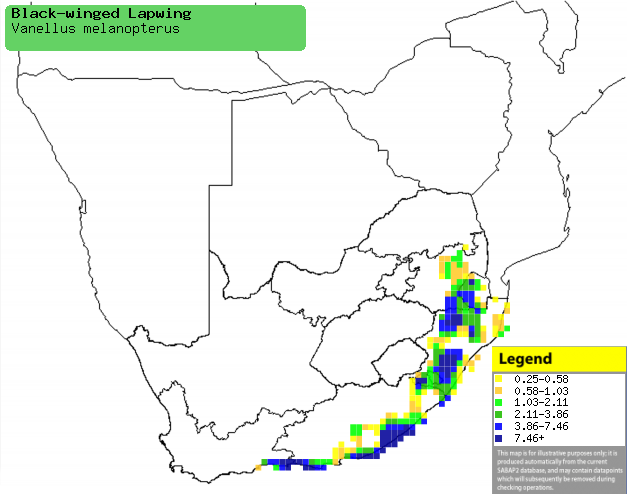|
Vanellus melanopterus
(Black-winged lapwing, Black-winged plover)
Grootswartvlerkkiewiet [Afrikaans]; Igxiya (also applied
to Crowned lapwing) [Xhosa]; iHoye, iTitihoye [Zulu]; Zwartvleugelkievit
[Dutch]; Vanneau à ailes noires [French]; Schwarzflügelkiebitz [German];
Abibe-d'asa-negra [Portuguese]
Life
> Eukaryotes >
Opisthokonta
> Metazoa (animals) >
Bilateria >
Deuterostomia > Chordata >
Craniata > Vertebrata (vertebrates) > Gnathostomata (jawed
vertebrates) > Teleostomi (teleost fish) > Osteichthyes (bony fish) > Class:
Sarcopterygii (lobe-finned
fish) > Stegocephalia (terrestrial
vertebrates) > Tetrapoda
(four-legged vertebrates) > Reptiliomorpha > Amniota >
Reptilia (reptiles) >
Romeriida > Diapsida > Archosauromorpha > Archosauria >
Dinosauria
(dinosaurs) > Saurischia > Theropoda (bipedal predatory dinosaurs) >
Coelurosauria > Maniraptora > Aves
(birds) > Order: Charadriiformes
> Family: Charadriidae > Genus: Vanellus
Distribution and habitat
Occurs in the highland grassland of Ethiopia, southern
Kenya and northern Tanzania, with a separate population in southern Africa.
Within southern Africa
it is uncommon to locally common from Mpumalanga south though Swaziland to
KwaZulu-Natal, extending down the coast through the Eastern Cape to the far east
of the Western Cape. It generally prefers highland plateaux and slopes, meadows,
fallow fields, pastures, coastal flats and areas of mown grass, such as golf
courses.
|
 |
|
Distribution of Black-winged lapwing in southern Africa,
based on statistical smoothing of the records from first SA Bird Atlas
Project (©
Animal Demography unit, University of
Cape Town; smoothing by Birgit Erni and Francesca Little). Colours range
from dark blue (most common) through to yellow (least common).
See here for the latest distribution
from the SABAP2. |
Predators and parasites
- Predators
- of adults
- of eggs
- of chicks
- of chicks and eggs
Movements and migrations
Altitudinal migrant, breeding at highland
inland areas from late August-November, after which it heads
down to the coast until the following breeding season.
Food
It mainly eats termites (which form approximately 84-90% of
its diet),
often using the typical foraging technique of plovers, running, stopping, then
searching for prey before repeating the process. The following food items have been recorded
in its diet:
- Invertebrates
- insects
-
spiders
- molluscs
- earthworms
- Vertebrates
Breeding
- Monogamous, territorial solitary or loosely colonial nester, sometimes
breeding along with Spotted
thick-knees and Crowned lapwings.
The male defends a small territory surrounding the nest, calling from an
elevated mound and repelling intruders by flicking its tail downward and
bobbing its whole body back and forth.
- The nest is a scrape or depression in the ground, lined with roots, small
stones and dried dung and typically placed among grass or in newly ploughed
land.
- Egg-laying season is from May-November, peaking from August-September.
- It lays 1-4 eggs, which are incubated by both sexes by day but only the
female at night, for about 30-31 days.
- The chicks remain in the nest for up to 24 hours while their down dries,
after which they follow their parents away, who direct them to food for them
to eat. They fledge at about 29-31 days old, remaining with the
adults for about a year before leaving at the onset of the following
breeding season.
Threats
Not threatened, since its specialised habitat requirements
are fulfilled by veld-burning, heavy grazing and mowing.
References
-
Hockey PAR, Dean WRJ and Ryan PG 2005. Roberts
- Birds of southern Africa, VIIth ed. The Trustees of the John Voelcker
Bird Book Fund, Cape Town.
|
